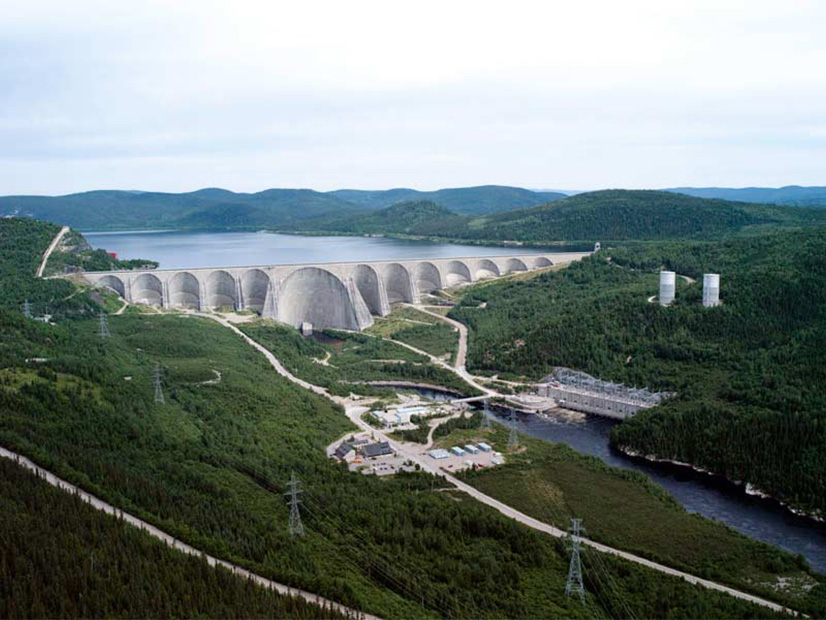As the Trump administration forged last-minute agreements with Canada and Mexico to postpone steep new tariffs, the energy industry fretted about potential fallout for cross-border supply chains and wholesale electricity markets.
President Donald Trump signed a series of executive orders Feb. 1 creating new tariffs on Mexico, Canada and China, purportedly a response to the countries’ failure to control drug trafficking and — in the case of the U.S. neighbors — illegal immigration.
The tariffs would include a 10% duty on Canadian energy, a 25% tariff on other Canadian goods and a 25% fee for all Mexican imports. On Feb. 3, the day before the tariffs were set to take effect, the U.S. announced a month-long pause on the tariffs on both countries, following agreements to increase security at both borders.
However, the administration is set to proceed with a new 10% tariff on all imports from China, which comes on top of steep tariffs imposed by the Biden administration on battery components, electric vehicles and solar cells from the country. (See Biden’s New Tariffs Target China’s Dominance in Solar, EV Markets.)
Much of the uncertainty around the tariffs stemmed from vague language in the executive order regarding the lower tariffs for “energy or energy resources.”
The definition referenced by the order classifies energy and energy resources as “crude oil, natural gas, lease condensates, natural gas liquids, refined petroleum products, uranium, coal, biofuels, geothermal heat, the kinetic movement of flowing water and critical minerals.”
Electricity is not explicitly mentioned in the order or the definition of energy or energy resources, and uncertainty remains regarding how the administration would levy a fee on electricity imports from Canada.
Responding to the order, energy executives representing a wide range of interests expressed concerns about potential cost impacts.
Jason Grumet, CEO of American Clean Power, said in a statement that the organization “is concerned that increasing the costs of energy production inputs will put upward pressure on consumer energy costs and diminish our capacity to unleash energy abundance.”
He noted that components needed for solar panels, wind turbines and batteries are manufactured in Mexico and Canada and said the United States-Mexico-Canada Agreement has “been a positive factor in lowering American energy costs.”
Connor Teskey, CEO of Brookfield Renewable, told investors Jan. 31 that added costs from tariffs on the renewable components ultimately will be passed on to ratepayers via more expensive power purchase agreements.
“The demand is stronger than ever before. … Should these things change the economics of a project, we will very simply push it through the PPA price,” Teskey said.
Fossil fuel industry representatives also expressed concern about the tariffs. American Petroleum Institute CEO Mike Sommers noted that American refineries rely on crude imports from Canada, adding that Mexico is the top destination for exports of refinery products, while fossil fuel exports to China totaled over $14.4 billion in 2023.
“Energy markets are highly integrated, and free and fair trade across our borders is critical for delivering affordable, reliable energy to U.S. consumers,” Sommers said.
Electrical Uncertainty
Significant uncertainty remains regarding how the tariffs would affect wholesale electricity markets, and whether the administration could even put a tariff on electricity imports.
A representative of the U.S. International Trade Commission declined to comment on the executive order, but highlighted a provision in the Harmonized Tariff Schedule that states electricity “shall not be subject to the entry requirements for imported merchandise set forth in section 484 of the Tariff Act of 1930.”
They also linked a 2021 report by the ITC that noted “imports of electrical energy are not considered to be subject to the tariff laws of the United States.”
From the standpoint of electricity trading, Canadian provinces are more plugged into U.S. markets than to each other, according to the Canada Energy Regulator (CER), which regulates electricity exported from Canada.
“Most of Canada’s electricity trade is with the U.S., as opposed to between provinces,” the CER notes on its website.
The latest figures from the CER show Canada exported 32,750,232 MWh of electricity to the U.S. over January-November 2024 at an average price of $CAN61.45/MWh, while importing 21,471,172 MWh. The country’s exports, largely produced by hydroelectric dams, were valued at nearly CAN$2.82 billion over that period, with imports estimated at about CAN$1.25 billion.
Ontario was the largest exporter, at 10,975,316 MWh, followed by British Columbia (5,895,148 MWh), Manitoba (5,682,762 MWh) and Québec (5,330,654 MWh).
But the relationship has long been symbiotic, with the U.S. receiving significant economic — and reliability — benefits from Canada’s surpluses.
In New England, imports from Canada are an important part of the resource mix, even as a major drought has caused decreased hydropower generation in Québec over the past two years.
Net imports across tie lines with Canada were used to meet about 5% of the New England’s total electricity demand in 2024. As recently as 2022, net imports across these lines covered over 13% of the region’s total electricity use. (See New England Gas Generation Hit a Record High in 2024.)
Even in a down year for hydropower in 2024, imports played a major role in preserving grid reliability during a pair of capacity scarcity events in the summer. Imports earned a combined $29 million in credits for performing during these periods, far more than any other resource type. (See NEPOOL Markets Committee Briefs: Dec. 10, 2024.)
A 10% increase in the cost of Canadian electricity would raise the market price paid to all participating resources when the imports are setting the market price. According to the ISO-NE Internal Market Monitor, external transactions — which include imports from both Canada and New York — were marginal 27% of the time in the day-ahead market in 2023.
“With the caveat that we are entering uncharted waters, at this time I do not expect this to have a major impact on electricity imports into New England,” said Dan Dolan, president of the New England Power Generators Association. “NEPGA’s observations are that those north-to-south flows tend to be less economically driven and more about what raw availability is available in excess of native load.”
However, the tariffs could create challenges for long-term state contracts for power from Canada, he noted. Hydro-Québec has a long-term contract with Vermont, supplying the state with about a quarter of its total electricity needs.
The company also has signed long-term contracts with Massachusetts for the New England Clean Energy Connect (NECEC) transmission line, slated to come online at the end of 2025, and with New York for the Champlain Hudson Power Express, which is projected to finish construction in 2026. These projects could significantly increase the amount of power imported into the Northeast U.S. from Canada.
“Contracted electricity associated with a fixed cost may require regulatory or contractual adjustments,” Dolan said. He also expressed concern that hydropower would be the only type of generation eligible for the lower 10% tariff, while other sources of power may face the full 25% duty because of the vague language in the executive order.
Larry Chretien, executive director of the Green Energy Consumers Alliance, noted that NECEC will provide about 15 to 20% of Massachusetts’ electricity. A 10% tariff on these imports “makes the deal far less attractive,” he said.
A representative of Hydro-Québec said the company is “closely monitoring” the situation, including potential impacts on short-term energy sales and long-term contracts, adding that it “will adjust our activities to limit impacts in Quebec.”
Joe LaRusso, manager of the Clean Grid Program at the Acadia Center, a New England-based climate advocacy group, said he does not think tariffs would have a major effect on New England resource mix, but said they likely would lead to an overall increase in electricity prices.
“It’s not good for a region that is already feeling the pinch of a significant energy burden,” LaRusso said, adding that the cost increases likely would be the most pronounced in the winter, when the region relies most heavily on imported electricity.
ISO-NE said it is reviewing the proposed tariffs, as well as potential responses from Canadian officials.
“We are seeking guidance from the administration on what, if any, role [ISO-NE] will be required to have in implementing these tariffs,” the RTO said. “We cannot speculate on what, if any, impact these actions will have on wholesale electricity prices or the level of imports into the region.”
NYISO wrote in a statement that it “is actively pursuing guidance pertaining to the impact on electricity markets and which Canadian energy resources qualify.”
Both Northeastern RTOs emphasized the close collaboration and ties between the power systems on both sides of the border.
BC Retaliation?
Western electricity markets faced a similar state of unease around the treatment of energy supplies from British Columbia, whose provincially owned utility, BC Hydro, shares control of hydroelectric output from the Columbia River system with its U.S. counterparts, the Bonneville Power Administration and the Army Corps of Engineers.
BC Hydro is closely integrated with the Western U.S. market through the operations of its marketing arm, Powerex, a sophisticated trader that markets the province’s ample surpluses of hydro generation and engages in arbitrage trades throughout the Western Interconnection.
Powerex accounts for nearly all the province’s exports into the U.S. and currently participates in CAISO’s Western Energy Imbalance Market (WEIM), although it recently said it eventually will leave that market to join SPP’s Markets+, for which it has been a key backer and the top funder. (See SPP Markets+ Tariff Wins FERC Approval.)
Asked what measures CAISO might have to take to account for the tariffs in its markets, ISO spokesperson Anne Gonzales told RTO Insider: “It’s too early to tell what kind of direct impacts the energy tariffs might have on our market and operations. We are monitoring developments closely as these policies become more defined.”
Powerex did not respond to a request for comment about the potential impact of the tariffs on its operations.
In December, Victoria News reported that British Columbia Premier David Eby said he would not rule out cutting the province’s electricity flows to the U.S. in retaliation to tariffs on Canada.
“We are prepared to support retaliatory tariffs and response to the United States that gets their attention to help them understand what the consequences would be for British Columbians and what the consequence would be for Americans,” Eby said during a Dec. 12 press conference, echoing a similar statement by Ontario Premier Doug Ford.
While Eby noted that British Columbia generally is a net importer of electricity, he also pointed to Powerex’s strategy of importing electricity from other parts of the West at a “much lower” cost during times of surplus, then selling back into U.S. states such as Washington, Oregon and California during critical periods of peak demand.
Evidence of the value of that relationship could be seen in January 2024, with Powerex counted among suppliers from across the West that helped prevent multiple utilities in the U.S. Northwest from resorting to rolling blackouts during an extended deep freeze accompanied by low hydro supplies and a fault in the region’s natural gas pipeline system. (See Powerex Report Expands NW Cold Snap Debate.)
Eby’s office did not respond to a question about whether he still might follow through on the threat to withhold electricity supplies from the U.S. in the face of tariffs.




